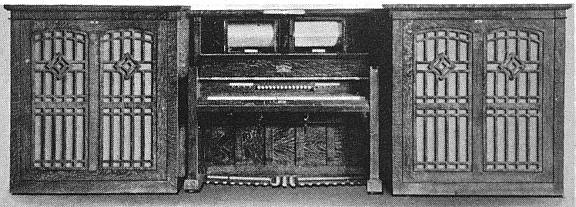
Back to Main Encylopaedia Contents
Prince George Theatre, Brighton

Little is known of the history of the instrument installed in the Prince George Theatre, Church Street, Brighton. It was a Cremona photo-player, built by the Marquette Piano Company, of 2421-2439 Wallace Street, Chicago. From the surviving details, it would appear that the instrument was a Cremona Style M3 photoplayer. According to David Bowers:
"This was one of the more popular Cremona photoplayer styles ... Cremona photoplayers were avail-able with the following roll systems: (1) Single tracker bar using 88-note home player piano rolls; (2) Duplex tracker bars using 88-note rolls and 134-note "S" rolls; (3) Duplex mechanisms using two "S" rolls; (4) Single tracker bar using "S" rolls. Although we haven't seen or heard of one, it would be logical to assume that 88-note duplex mechanisms were available also."
[Bowers, David Q., Encyclopędia of Automatic Musical Instruments, Vestal Press, Vestal, N.Y., 1972, p. 503]
These were versatile instruments:
"As could other makes of photoplayers, the Cremona instru-ments could be operated remotely (from the projection booth) by a push-button panel. This panel controlled the switching from one roll to the other and could turn the instrument on and off. It could not operate any of the sound effects normally controlled from the foot pedals. However, with an "S" roll in place, most of the interior instru-ments could be turned on and off automatically - and the absence of a fire gong or steamboat whistle wouldn't be missed."
[Bowers, David Q., Encyclopędia of Automatic Musical Instruments, Vestal Press, Vestal, N.Y., 1972, p. 503]
They were also built to last:
"Most connoisseurs of the mechanical piano consider the Cremona, manufactured by Chicago's Marquette piano Company, to be just about the Rolls Royce of the field. While a good many of the machines on the market were shabbily constructed, to say nothing of being poorly designed in the first place, no such complaints could be registered concerning the products of this company. As an example of the careful attention to promotion of longevity in the use of the instruments, note that the bellows were lined with "newborn calf-skin".
[Roehl, Harvey, Player Piano Treasury, Vestal Press, Vestal, N.Y., 1961 (1st edition), p. 123.]
Again:
"From a marketing viewpoint, Cremona instruments were 'overbuilt'. The interiors were usually lined with beautiful bird's eye maple and the interior chest and striker actions were made of mahogany, an attention to quality that could not have been appreciated by the Cremona patron in the 'good old days', as these features were hidden from view."
[Bowers, David Q., Encyclopędia of Automatic Musical Instruments, Vestal Press, Vestal, N.Y., 1972, p. 498]
Bowers goes on to say that "Cremona photoplayers had their heyday in the 'teens", [Bowers, David Q., Encyclopędia of Automatic Musical Instruments, Vestal Press, Vestal, N.Y., 1972, p. 503] and states elsewhere that Cremona instruments were mainly marketed from 1905 to 1920, [ibid., p. 498] so it would be safe to assume that this instrument was probably installed in the late 1910s or very early 1920s.
The Prince George instrument contained four full-compass (61 notes) ranks: Diapason, Flute, Cello, and Violin, and a treble-only Vox Humana. These were all available at 8ft pitch only, but Sub and Super-Octave couplers were provided. The only tonal percussion was a Xylophone.
The console had a single 88-note manual, which enabled the piano to be played full-compass; this could be set onto the bass and/or treble portions of the keyboard as required. There was a comprehensive array of traps and effects, which were controlled by push buttons and piano pedals. The roll-playing option was the second listed above, with duplexed 88-note and 134-note "S" orchestrated mechanisms.
The Style M3 "was over sixteen feet in width, from the extreme edge of the box on the left of the piano containing various drums and traps, to the right edge of the other external box which contained sets of organ pipes." [Roehl, Harvey, Player Piano Treasury, Vestal Press, Vestal, N.Y., 1961 (1st edition), p. 125.]
It is believed that the instrument last played in around 1930. It remained in the theatre until the 1960s, when it was taken out and stored out of doors in a nearby yard until wrecked by the elements. Its remains were eventually scrapped.
[Information, other than otherwise attributed, was provided by Julien Arnold, Melbourne, from his archives, September, 1975].